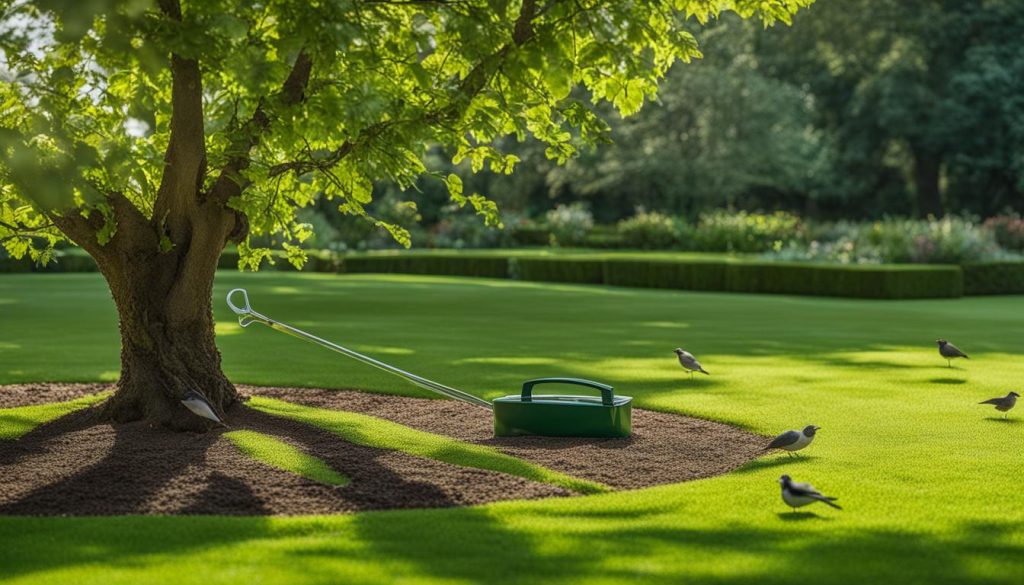Welcome to our guide on achieving a lush green yard! We understand that maintaining a beautiful lawn can be challenging, but with our essential lawn care tips, you can transform your yard into a vibrant oasis.
Whether you’re a seasoned gardener or a first-time homeowner, our tips will help you achieve a healthy and vibrant lawn. From preparing your lawn for success to controlling weeds and pests, we’ve got you covered. So, let’s get started on the journey to a lush green yard!
Preparing Your Lawn for Success
Before we dive into lawn care tips, it’s important to prepare your lawn for success. By doing so, you’ll set the foundation for a healthy, thriving yard.
Soil Testing
One of the first things you should do is conduct a soil test. This will help you determine the pH level and nutrient content of your soil, which is crucial for selecting the right fertilizer and ensuring your lawn is getting the nutrients it needs. You can purchase soil testing kits at your local garden center or send a sample to a soil testing lab for analysis.
Aeration
Aerating your lawn can help promote healthy root growth by allowing air, water, and nutrients to penetrate the soil. You can use a manual or mechanical aerator to create small holes in your lawn. This should be done in the fall or spring when the grass is actively growing.
Proper Mowing Practices
Proper mowing practices are vital for maintaining a healthy lawn. When mowing, it’s important to keep your mower blade sharp and adjust its height according to the season. During the summer, raise the blade to leave the grass longer, which will help protect the roots from heat stress.
Remove Debris and Weeds
Remove any debris or weeds from your lawn before caring for it. Debris can suffocate the grass, while weeds can compete for nutrients and water. Handpick or use a weeding tool to remove weeds, and rake up any debris.

By following these essential steps, you’ll be well on your way to a healthy, lush green lawn. Next, we’ll discuss the importance of feeding your lawn with nutrients.
Feeding Your Lawn with Nutrients
Feeding your lawn with the right nutrients is essential to keeping it healthy and green. Fertilization provides your lawn with the necessary nutrients to grow thick and lush. Choosing the right fertilizer can be overwhelming, but don’t worry, we’ve got you covered with these lawn care tips.
Choosing the Right Fertilizer
When choosing a fertilizer, consider the nutrient content and release rate. Nitrogen is the most important nutrient for your lawn, as it promotes leaf growth and a deep green colour. Look for a fertilizer with a high nitrogen content, like a 30-0-4 blend. The first number represents the nitrogen content, while the second and third represent phosphorus and potassium, respectively. Slow-release fertilizers are also recommended, as they release nutrients slowly over time, reducing the risk of fertilizer burn and promoting long-term growth.
When to Fertilize
The best time to fertilize your lawn is in the spring and fall, when temperatures are mild and grass is actively growing. Avoid fertilizing during the hot summer months, as this can stress your lawn and lead to burn spots. Apply fertilizer evenly across your lawn using a spreader, and be sure to follow the recommended application rate on the fertilizer package. Overfertilizing can damage your lawn and harm the environment.
Applying Fertilizer Effectively
To ensure your lawn receives the full benefits of fertilization, follow these lawn care tips for applying fertilizer:
- Mow your lawn before applying fertilizer to promote even coverage.
- Water your lawn before and after fertilizing to help the nutrients penetrate the soil.
- Avoid fertilizing on windy days, as this can cause uneven distribution and harm the environment.
- Clean your spreader thoroughly after use to prevent cross-contamination.
By following these tips for feeding your lawn with nutrients, you can promote healthy growth and maintain a lush green yard.
Watering Wisely for a Healthy Lawn
Proper watering is crucial for a healthy and thriving lawn. However, it’s not just about giving your grass enough water. You also need to make sure you’re watering it wisely.
Determining the Ideal Watering Schedule
The amount of water your lawn needs depends on various factors, such as the type of grass, soil, and weather conditions. Ideally, your lawn should receive about 1 to 1.5 inches of water per week, either from rainfall or irrigation. However, if there’s enough rainfall, you may not need to water your lawn at all.
One way to check if your lawn is receiving enough water is to use a rain gauge. Place the gauge in a well-irrigated area of your lawn and measure how much water it receives. You can also use a screwdriver or a soil probe to check the moisture level of your soil. If the top 6 inches of your soil are moist, then you’re watering your lawn correctly.
Tips for Effective Watering
When watering your lawn, it’s essential to do it effectively. Here are some tips:
- Water your lawn early in the morning to reduce evaporation and fungal growth.
- Avoid watering your lawn in the evening, as the grass will stay wet overnight and increase the risk of diseases.
- Use a sprinkler or irrigation system that distributes water evenly.
- Water your lawn deeply and infrequently. This will encourage deep root growth, making your lawn more resistant to drought and other stresses.
- Do not overwater your lawn, as it can cause shallow root growth, weed growth, and other problems.
By following these tips, you can ensure that your lawn receives the right amount of water, at the right time, and in the right way. This will promote healthy growth, reduce water waste, and save you money on your water bill.

Controlling Weeds and Pests
Dealing with weeds and pests in your lawn can be a frustrating and time-consuming task. However, with the right strategies and techniques, it is possible to control them effectively and keep your lawn healthy and lush.
Identifying the Problems
The first step in controlling weeds and pests is identifying the problems correctly. For weed control, it’s important to determine which types of weeds are growing in your lawn and then select the appropriate herbicide. For pest control, it’s crucial to identify the type of pest, such as insects, rodents, or other animals, and then choose the most effective control measures.
If you’re not sure what’s causing the issue in your lawn, you can consult with a lawn care professional or take advantage of diagnostic tools and resources offered by your local gardening center.

Natural Remedies
Many homeowners prefer to use natural remedies for controlling weeds and pests to avoid exposure to harmful chemicals and protect the environment. Natural solutions can be effective against many common lawn problems, such as dandelions, clover, and grubs.
- Hand-pulling weeds: Pulling weeds by hand can be tedious, but it is an effective way to reduce their growth.
- Mulching: Mulching around plants can help suppress weed growth and improve soil quality.
- Organic pest control products: There are many natural pest control products on the market that use ingredients like garlic, peppermint, and neem oil.
Targeted Treatments
In some cases, natural remedies may not be enough to control weeds and pests. If the problem persists, you may need to use targeted treatments, such as chemical herbicides or insecticides.
When using chemical treatments, it’s essential to follow the manufacturer’s instructions carefully and take appropriate safety precautions, such as wearing gloves and protective clothing.
If you’re not comfortable using chemical products, you can hire a professional lawn care provider to handle the problem for you.
Preventative Measures
The best way to control weeds and pests in your lawn is to prevent them from taking hold in the first place. Here are some preventative measures you can take:
- Keep your lawn healthy: A healthy lawn is less susceptible to weed and pest problems. Make sure to fertilize and water your lawn properly.
- Mow your lawn regularly: Regular mowing can prevent weeds from going to seed and also helps to reduce pest habitat.
- Remove debris: Remove any debris, such as fallen leaves and branches, from your lawn regularly. This can provide hiding places for pests like rodents.
By following these tips and being vigilant about weed and pest control, you can maintain a beautiful and thriving lawn all season long.
Year-Round Maintenance and Troubleshooting
Maintaining a lush green lawn requires regular care and attention throughout the year. Here are some year-round lawn care tips to help you keep your yard healthy and vibrant:
Spring
Spring is the perfect time to give your lawn a boost after the long winter months. Rake up any remaining leaves and debris, and overseed bare patches for a fuller lawn. Aerate compacted soil to improve drainage and promote healthy root growth. Apply a slow-release fertilizer to feed your lawn with essential nutrients.
Summer
Summer can be tough on your lawn, with heat and drought posing significant challenges. To keep your lawn healthy, water it deeply and infrequently, preferably in the early morning or late evening. Raise your mower blade to leave your grass longer, which will help it retain moisture. Keep an eye out for pests and disease, and take prompt action if you spot any signs of trouble.
Fall
Fall is the time to prepare your lawn for the winter ahead. Keep raking leaves and debris to prevent them from smothering your grass. Continue watering as needed, and fertilize again to help your lawn store nutrients for the winter months. Overseed any bare patches, and consider applying a top dressing of compost to improve soil quality.
Winter
Winter is a time when your lawn is mostly dormant, but it still needs some care. Avoid walking on your lawn when it’s covered in snow, as this can damage the grass blades. Keep an eye on any snow mold or other winter-related diseases, and take action if necessary. When the snow melts, gently rake up any debris and overseed if needed.
By following these year-round lawn care tips, you can keep your yard looking its best. However, even with the best of care, problems can still arise. Here are some common lawn issues you may encounter and how to troubleshoot:
Bare Patches
If your lawn has bare patches, overseeding is the best solution. Choose a seed mix that’s suitable for your region and soil type. Rake the soil to loosen it and create a seedbed, then spread the seed evenly. Water regularly, and avoid mowing until the new grass is at least 3 inches tall.
Weeds
Weeds can be a nuisance in any lawn, but there are ways to control them. Hand-pulling is effective for small patches, but for larger areas, a herbicide may be needed. Choose a selective herbicide that targets the specific weed you’re trying to eliminate. Be sure to follow the product instructions carefully to avoid damaging your lawn.
Grubs
Grubs are the larvae of beetles, and they can cause significant damage to your lawn if left unchecked. Look for signs of grub infestation, such as dead patches of grass or animals digging in your lawn. If you spot grubs, apply a grub control product according to the package instructions. Water your lawn thoroughly after application to help the product penetrate the soil.
With these year-round maintenance and troubleshooting tips, you’ll be equipped to handle any challenges that come your way and enjoy a healthy and vibrant lawn all year long.
Our landscapers at Landscaper Near Me are dedicated to executing quality work and providing outstanding customer service, every time. Call us!
FAQ
What are some essential lawn care tips for achieving a lush green yard?
Follow these essential lawn care tips to achieve a lush green yard: proper mowing techniques, regular watering, fertilization, weed control, and year-round maintenance.
How do I prepare my lawn for success?
To prepare your lawn for success, make sure to conduct a soil test, remove any debris or weeds, aerate the soil, and perform necessary mowing and trimming before applying fertilizers or treatments.
How and when should I feed my lawn with nutrients?
It is important to choose the right fertilizer for your lawn and apply it according to the recommended schedule. Typically, fertilizing during the spring and fall seasons, with additional applications as needed, can provide your lawn with the necessary nutrients for healthy growth.
What are the best practices for watering my lawn?
Water your lawn deeply and infrequently to encourage deep root growth. It is generally recommended to water your lawn early in the morning, allowing it to dry before nightfall to prevent fungal diseases. Adjust your watering schedule based on weather conditions and the specific needs of your grass type.
How can I control weeds and pests without harming my lawn?
To control weeds and pests, consider using natural remedies, like hand-pulling or organic herbicides. Identify the specific types of weeds or pests you are dealing with to choose the most appropriate treatment method. Follow product instructions carefully and avoid overuse.
What year-round maintenance tasks should I perform for a healthy lawn?
Year-round maintenance includes tasks such as overseeding, dethatching, aerating, and regular mowing. It is also important to address any common lawn issues promptly, such as brown patches, bare spots, or fungal diseases.

